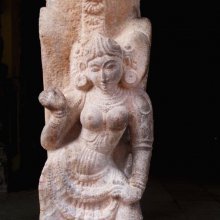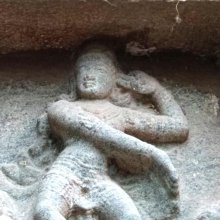Keshabandha, Kesha-bandha, Keśabandha, Keshabamdha, Keshabamdhana: 12 definitions
Introduction:
Keshabandha means something in Hinduism, Sanskrit. If you want to know the exact meaning, history, etymology or English translation of this term then check out the descriptions on this page. Add your comment or reference to a book if you want to contribute to this summary article.
The Sanskrit term Keśabandha can be transliterated into English as Kesabandha or Keshabandha, using the IAST transliteration scheme (?).
Images (photo gallery)
In Hinduism
Natyashastra (theatrics and dramaturgy)
Source: Wisdom Library: Nāṭya-śāstraKeśabandha (केशबन्ध) refers to a gesture (āṅgika) made with ‘dance hands’ (nṛttahasta), according to the Nāṭyaśāstra chapter 8. The hands (hasta) form a part of the human body which represents one of the six major limbs (aṅga) used in dramatic performance. With these limbs are made the various gestures (āṅgika), which form a part of the histrionic representation (abhinaya).
Source: archive.org: The mirror of gesture (abhinaya-darpana)1) One of the saṃyutta-hastāni (Twenty-six combined Hands).—Keśa-bandha (tying the hair): Patāka hands binding the hair. Patron deity Durgā. Usage: gem-pillar, binding the hair, cheek, etc.
2) Keśa-bandha is one of the saṃyutta-hastāni (Twenty-seven combined Hands).
Source: archive.org: Natya ShastraKeśabandha (केशबन्ध).—A type of gesture (āṅgika) made with dance-hands (nṛttahasta);—(Instructions): The two hands moved out from the hair-knot (keśabandha) and held on the sides. The Dance-hands are to be used in forming Karaṇas.

Natyashastra (नाट्यशास्त्र, nāṭyaśāstra) refers to both the ancient Indian tradition (shastra) of performing arts, (natya—theatrics, drama, dance, music), as well as the name of a Sanskrit work dealing with these subjects. It also teaches the rules for composing Dramatic plays (nataka), construction and performance of Theater, and Poetic works (kavya).
Shilpashastra (iconography)
Source: Google Books: Elements of Hindu iconographyKeśabandha (केशबन्ध):—A mode of dressing hair.—The mode called keśabandha is employed in relation to Sarasvatī among divine beings, and in relation to the queens of adhirājas among human beings.
Source: Shodhganga: Vaisnava Agamas And Visnu ImagesKeśabandha (केशबन्ध) refers to “hair-styles”, as defined in treatises such as the Pāñcarātra, Pādmasaṃhitā and Vaikhānasa-āgamas, extensively dealing with the technical features of temple art, iconography and architecture in Vaishnavism.

Shilpashastra (शिल्पशास्त्र, śilpaśāstra) represents the ancient Indian science (shastra) of creative arts (shilpa) such as sculpture, iconography and painting. Closely related to Vastushastra (architecture), they often share the same literature.
Languages of India and abroad
Sanskrit dictionary
Source: DDSA: The practical Sanskrit-English dictionaryKeśabandha (केशबन्ध).—
1) a hair-band; (virājase) मुकुटेन विचित्रेण केशबन्धेन शोभिना (mukuṭena vicitreṇa keśabandhena śobhinā) Mahābhārata (Bombay) 4.6.12.
12) a particular position of hands in dancing.
Derivable forms: keśabandhaḥ (केशबन्धः).
Keśabandha is a Sanskrit compound consisting of the terms keśa and bandha (बन्ध).
Source: Cologne Digital Sanskrit Dictionaries: Benfey Sanskrit-English DictionaryKeśabandha (केशबन्ध).—m. a hair fillet, [Bhāgavata-Purāṇa, (ed. Burnouf.)] 8, 12, 28. Daśabandha, i. e.
Keśabandha is a Sanskrit compound consisting of the terms keśa and bandha (बन्ध).
Source: Cologne Digital Sanskrit Dictionaries: Cappeller Sanskrit-English DictionaryKeśabandha (केशबन्ध).—[masculine] hair-band.
Source: Cologne Digital Sanskrit Dictionaries: Monier-Williams Sanskrit-English Dictionary1) Keśabandha (केशबन्ध):—[=keśa-bandha] [from keśa] m. a hair-band, [Mahābhārata iv, 190; Bhāgavata-purāṇa]
2) [v.s. ...] = -veṣa, [cf. Lexicographers, esp. such as amarasiṃha, halāyudha, hemacandra, etc.]
3) [v.s. ...] a particular position of the hands in dancing.
[Sanskrit to German]
Sanskrit, also spelled संस्कृतम् (saṃskṛtam), is an ancient language of India commonly seen as the grandmother of the Indo-European language family (even English!). Closely allied with Prakrit and Pali, Sanskrit is more exhaustive in both grammar and terms and has the most extensive collection of literature in the world, greatly surpassing its sister-languages Greek and Latin.
Kannada-English dictionary
Source: Alar: Kannada-English corpusKēśabaṃdha (ಕೇಶಬಂಧ):—
1) [noun] a binding of hair; hair tied into a bundle.
2) [noun] (dance.) one of the dance hand gestures in which one of the hands placed at the hip is turned down and the other turned up and both moved alternatively from shoulder to hip and hip to shoulder.
--- OR ---
Kēśabaṃdhana (ಕೇಶಬಂಧನ):—[noun] = ಕೇಶಬಂಧ- [keshabamdha-] 1.
Kannada is a Dravidian language (as opposed to the Indo-European language family) mainly spoken in the southwestern region of India.
See also (Relevant definitions)
Partial matches: Kesa, Bandha.
Full-text: Samyutta-hastani, Mauli, Nrittahasta, Latabha, Shobhin.
Relevant text
Search found 6 books and stories containing Keshabandha, Kesha-bandha, Keśabandha, Keshabamdha, Keshabamdhana, Keśa-bandha, Kesabandha, Kesa-bandha, Kēśabaṃdha, Kēśabandha, Kēśa-bandha, Kesabamdha, Kēśabaṃdhana, Keshabandhana, Kēśabandhana, Kesabamdhana, Kesabandhana; (plurals include: Keshabandhas, bandhas, Keśabandhas, Keshabamdhas, Keshabamdhanas, Kesabandhas, Kēśabaṃdhas, Kēśabandhas, Kesabamdhas, Kēśabaṃdhanas, Keshabandhanas, Kēśabandhanas, Kesabamdhanas, Kesabandhanas). You can also click to the full overview containing English textual excerpts. Below are direct links for the most relevant articles:
Abhinaya-darpana (English) (by Ananda Coomaraswamy)
Head-Gears in Hindu Art < [March 1937]
Cosmetics, Costumes and Ornaments in Ancient India (by Remadevi. O.)
2.1. Various other Head Ornaments < [Chapter 3 - Ornaments]
Manasara (English translation) (by Prasanna Kumar Acharya)
Chapter 49 - The crowns (mauli) and coronation (abhiṣeka)
Chapter 54 - The altar (śakti-lakṣaṇa)
Part 5 - General survey (summary of contents) < [Preface]
Middle Chola Temples (by S. R. Balasubrahmanyam)
Temples in Dadapuram < [Chapter II - Temples of Rajaraja I’s Time]
Natyashastra (English) (by Bharata-muni)
Related products


